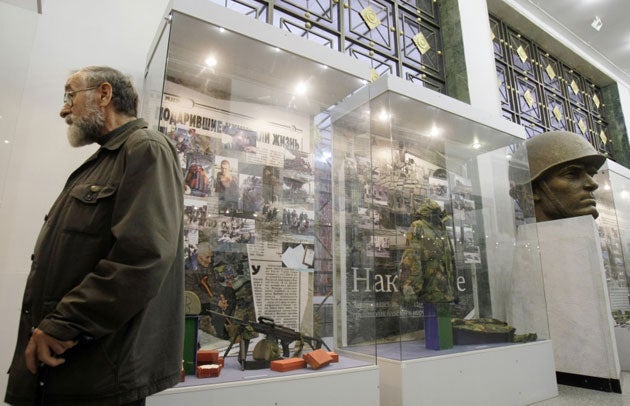Russia shows off the spoils of war in Georgia

Your support helps us to tell the story
From reproductive rights to climate change to Big Tech, The Independent is on the ground when the story is developing. Whether it's investigating the financials of Elon Musk's pro-Trump PAC or producing our latest documentary, 'The A Word', which shines a light on the American women fighting for reproductive rights, we know how important it is to parse out the facts from the messaging.
At such a critical moment in US history, we need reporters on the ground. Your donation allows us to keep sending journalists to speak to both sides of the story.
The Independent is trusted by Americans across the entire political spectrum. And unlike many other quality news outlets, we choose not to lock Americans out of our reporting and analysis with paywalls. We believe quality journalism should be available to everyone, paid for by those who can afford it.
Your support makes all the difference.The Russian army has put on display war trophies captured during the Georgia conflict at a museum in Moscow, in an attempt to reinforce its claim that the United States and the West were responsible for encouraging Georgia to attack its breakaway region of South Ossetia. After Moscow officially recognised South Ossetia and Abkhazia as independent 10 days ago, the exhibition is another sign that, far from caving under Western criticism of its actions, Russia is keen to milk the propaganda spoils of the war.
The display, at The Central Museum of Armed Forces, displays weapons, uniforms and personal possessions belonging to Georgian soldiers killed or wounded during the fighting along with graphic photographs of the burnt and mutilated bodies of dead Georgian soldiers.
A museum guide, who was showing a group of Russians around the exhibit, paused at a display showing the personal photos of a dead Georgian soldier. One of them showed him having dinner with relatives, another had him in a comradely pose with a black man.
"Look, here's one of the Georgian soldiers with a black-skinned man, an African," said the guide. "We all know that there are a lot of Africans in the US Army, this was probably one of his instructors." Also on display are a set of textbooks entitled American Language Course, Level IV. The museum claims they were taken from a Georgian soldier in South Ossetia, though it might seem improbable that the soldier would take the bulky books with him to the battleground of Tskhinvali.
The museum itself is mostly devoted to the Soviet army, and its labyrinthine set of halls mainly cover the Second World War. A tank from that war stands on a plinth outside, and a 10ft-high bust of Lenin greets visitors as they walk into the main hall. Most of the exhibitions offer a very skewed and unrevised Soviet version of history – the section on the building of the Soviet army in the 1920s does not once mention Leon Trotsky, who was instrumental in organising the early Red Army but later fell out of favour with Stalin and was erased from Soviet history books. The Second World War section glosses over controversial aspects of the war, and Russia's long and costly conflicts in Afghanistan and Chechnya are hardly mentioned.
The same approach seems to have been taken for the Georgia exhibition. In a Soviet-style touch, there are more than a dozen photographs of President Dmitry Medvedev, and an array of his speeches and orders to the military during the conflict. A timetable of the war leaves out several important events. There is also a distinctly anti-Western tone to the exhibition, with several pieces of "Nato" equipment and army clothing on display, and a list of which Western countries had armed Georgia.
The graphic nature of some of the exhibits shows the depth of ill-feeling that has developed between Russia and Georgia after last month's conflict. Both sides have paraded their war gains in public – when the Georgians shot down four Russian pilots at the height of the conflict last month they paraded two bodies on national television, and The Independent was later given access to interview the two surviving pilots.
Russia is now taking its turn to display the spoils of the war which it unequivocally won. Moscow has been angry over the coverage that the conflict received in the West, and is insistent that the conflict was provoked by the Georgian President Mikheil Saakashvili, with tacit backing from the West.
Last week Mr Medvedev said that Russia would "consistently and meticulously" re-equip its armed forces, which have a reputation of being poorly trained, underpaid and rife with bullying. "There is no doubt that our decision has been influenced by the events in the Caucasus," he said. "They have made this task one of the top priorities for the next few years."
Subscribe to Independent Premium to bookmark this article
Want to bookmark your favourite articles and stories to read or reference later? Start your Independent Premium subscription today.
Join our commenting forum
Join thought-provoking conversations, follow other Independent readers and see their replies
Comments